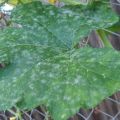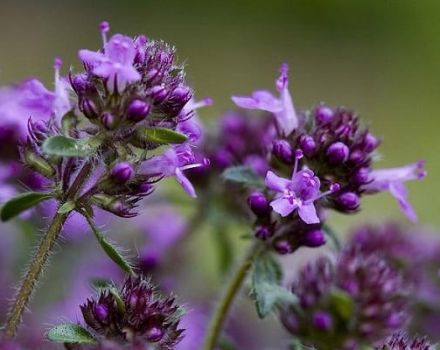Measures to combat powdery mildew on roses, what to do and what is the best treatment
In summer, most ornamental plants are exposed to fungal infection - powdery mildew; on roses and other flowers, the disease appears as a white bloom on the leaves. With further spread, the fungus affects the stems and buds. To protect the plants, you should find out the cause of the development of the disease, and also choose the most appropriate method of struggle.
The causes of the disease
Powdery mildew is most clearly manifested on roses, measures to combat the disease depend on the reasons that provoked the fungal infection. Risk factors include:
- increased air humidity;
- excessive or insufficient watering;
- a large amount of precipitation;
- high concentration of nitrogen in the soil;
- insufficient sunlight;
- too close arrangement of bushes to each other.
Infection of roses occurs in the case of creating a favorable environment for the reproduction of the fungus, and this is, first of all, dampness. Therefore, for effective treatment and prevention of re-infection, care should be adjusted and comfortable conditions for the life of the plant should be provided.
Signs of illness
Recognizing the disease is easy enough. It is not like other types of fungal infection. Its characteristic features include:
- The appearance of plaque on the sheet plate. Young shoots are more susceptible to infection, on which the fungus settles in the form of a white powder.
- Spots on the leaves. Reddish-purple spots and ulcers may appear on the leaf plate.
- Pustules on the stem. The mycelium of the fungus is localized on the stem of the rose in the form of small growths. During the development of the disease, pustules increase their area and density.
- Stopping plant growth.
- Deformation and fall of leaves.

The leaves that are closer to the ground are affected first. With an advanced form of the disease, plaque spreads to the stems and buds. At the same time, the leaves are deformed and do not return their shape even after treatment with drugs.
White bloom covers the leaf blade, thereby creating an obstacle to photosynthesis. As a result, the plant does not receive the necessary nutrients and looks lifeless.
Downy mildew is an equally common disease of roses, which has a similarity in characteristics. But there are some differences in its manifestation. Instead of white bloom, red-brown or purple spots appear on young leaves, and mature leaves brighten and acquire a gray tint. In this case, a dense layer similar to a cobweb forms on the back of the plate.These symptoms are often associated with acid rain or sunburn. This disease should be treated with a boric acid solution (5 grams per 5 liters of water).
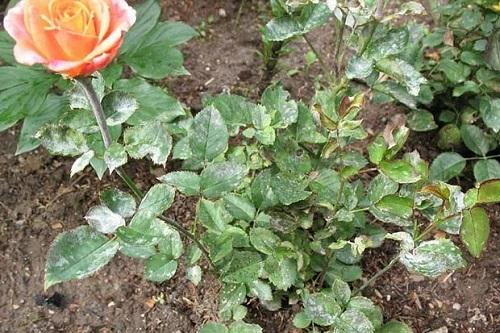
Methods for treating powdery mildew on flowers
You can get rid of powdery mildew on roses with the help of special chemicals and folk remedies. It should be noted that the disease is developing rapidly. Within two weeks, the plant can be completely covered with powdery mildew. Therefore, at the first sign of infection, decontamination measures must be taken.
Chemicals
Fungicides are presented in a wide variety of contact and systemic agents. Contact fungicides are characterized by the destruction of the fungus upon external contact with it. Systemic drugs penetrate the tissues of the plant and poison the juice, which has a detrimental effect on the causative agent of the disease.
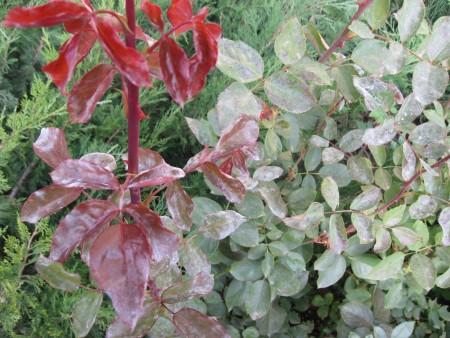
Many gardeners use antibiotics such as streptomycin and penicillin to treat powdery mildew on roses. But experts do not consider this method effective, since antibiotics are not able to destroy the fungus. They are more effective against viruses.
Chemical treatment implies a certain procedure:
- Remove all affected parts of the stem from the rose. Remove fallen leaves from the ground.
- Spraying should be done in calm weather, in the morning or in the evening.
- Thoroughly treat the bush with the preparation, wetting the leaves, both from the top and from the bottom.
- Indoor roses can be completely dipped in the prepared solution. You should also process the walls of the pot and pallet.
- To improve the effect, systemic and contact fungicides should be alternated.
- When spraying, be sure to cultivate the land around the bush.
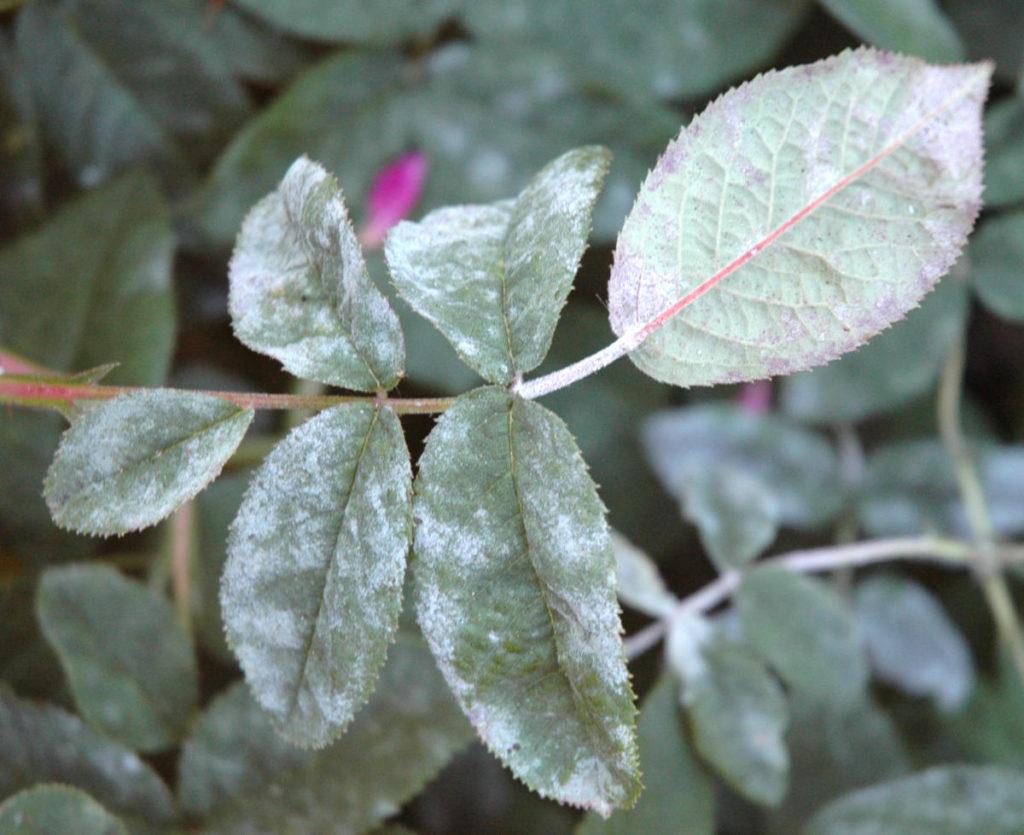
This algorithm of actions is applicable to indoor roses. They are treated with the same drugs that are used for street bushes.
Fundazol
It is necessary to dilute the drug in a proportion of 5 grams of the product per 5 liters of water. When processing 1.5 liters of solution is consumed per 10 square meters of planting area. Fundazole is used at the first signs of damage to roses. Re-treatment should be carried out after 2 weeks.
Topaz
The systemic fungicide Topaz should be diluted at the rate of 1 milliliter of the drug per 2.5 liters of water. Solution consumption during processing is 1.5 liters per 10 square meters. Re-processing of roses is done after 2 weeks. Topaz can also be used for preventive spraying.
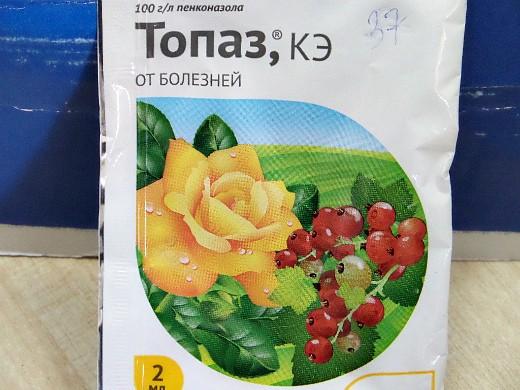
Speed
The fungicide has both contact and systemic effects. To prepare the solution, it is necessary to dilute 1 milliliter of the product in 5 liters of warm water. The distribution of the prepared solution takes place in the calculation of 1 liter per 10 square meters of plantings. If necessary, the treatment should be repeated after 10-14 days. Suitable for treatment and prevention.
Important! To prevent the fungus from getting used to the drug, you should not use one fungicide more than three times in a row.
Folk remedies
In addition to chemical exposure, powdery mildew can be eliminated using folk remedies.
Milk whey solution
Add 10 drops of iodine to the serum diluted with water (1:10). Roses are processed before noon. You can repeat the procedure after 10 days. In addition to disinfection, serum contributes to the saturation of the plant with micronutrients.

Soap-soda solution
The spray compound is made on the basis of baking soda and laundry soap. Dissolve 2 tablespoons of soda in 5 liters of water. Add 1 tablespoon of soap shavings to the resulting composition. For prophylaxis, the solution is used once every 2 weeks. For the treatment of roses, the frequency of treatments is increased to 3 times a month.
You can also use soda ash. For the solution, you need to dilute 50 grams in 10 liters of water. Add 40 grams of laundry soap. Process no more than 2 times with an interval of 7 days.
Mustard solution
Dissolve 1 tablespoon of mustard powder in 5 liters of hot water. The solution is used after cooling down, for surface spraying and watering.

Garlic infusion
To prepare a solution of 25 grams of chopped garlic, pour 1 liter of water. The composition should be infused within 24 hours. Then it is filtered and used for its intended purpose.
Infusion of fresh manure
Fresh manure in the amount of 1/3 of the bucket is poured with 10 liters of water. Insist 3 days. The settled water is poured off, and the concentrated precipitate is diluted, keeping the proportions 1:10.
Important! When using fresh manure, the proportions must be strictly observed. High concentration can cause burns.
Prevention of the disease
For the prevention of powdery mildew damage to roses, you should follow the rules of agricultural technology.

To maintain plant health, you must:
- adhere to the rules of planting and pruning;
- inspect roses regularly;
- remove weeds and fallen leaves, which become a source of disease;
- adhere to the sterility of the tools when pruning roses;
- control the dosage of nitrogen-containing fertilizers;
- provide enough calcium and phosphorus for the plant;
- to carry out preventive treatment with fungicides;
- in the fall, carefully remove the leaves around the bush and dig up the soil.
For more likely protection, it is better to choose varieties of roses that are resistant to this fungal disease.
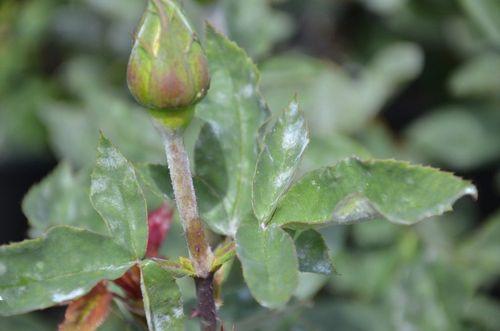
Powdery Mildew Resistant Rose Varieties
When buying roses, you should pay special attention to varieties that are characterized by resistance to powdery mildew. Thanks to the labors of breeders, the choice of such roses is quite wide. The most popular among them:
- Purple Tiger;
- Cadillac;
- Hot chocolate;
- Rosoman Jeanon;
- Crocus Rose;
- Westminster;
- Gloria Day;
- Halle;
- Aphrodite.
These varieties thrive in damp climates and are suitable for both home and greenhouse cultivation.
The appearance of powdery mildew on roses is most often the result of improper care and an unsuitable climate. Subject to preventive measures, the plant will delight its owner with a long flowering and healthy appearance.




